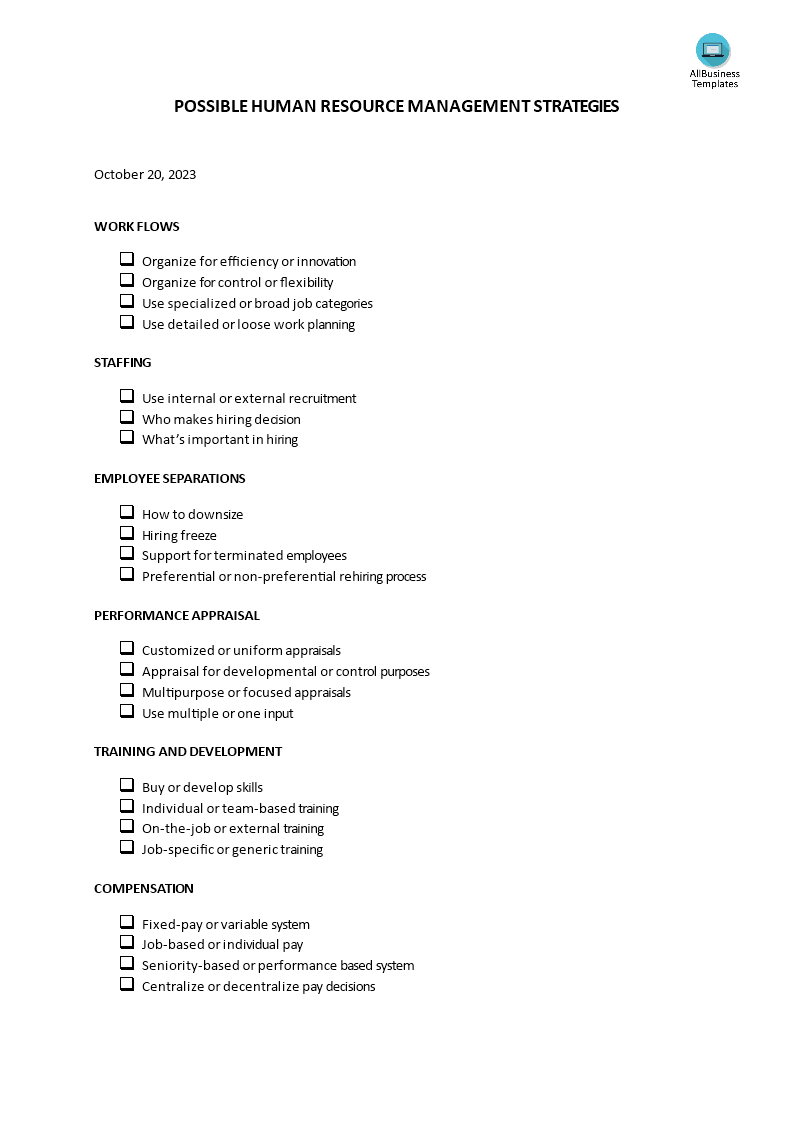Human Resource Management Strategies
Save, fill-In The Blanks, Print, Done!

Download Human Resource Management Strategies
Today: USD 2.99
Download It Now

Available premium file formats:
Microsoft Word (.docx)- This Document Has Been Certified by a Professional
- 100% customizable
- This is a digital download (25.04 kB)
- Language: English
- You will receive a link to download the file as soon as your payment goes through.
- We recommend downloading this file onto your computer.
Do you need to plan your human resource management strategy for the coming years? Why do we need human resource management strategies? Our templates are designed to help businesses streamline their HR processes and increase efficiency. Download our templates now which you can customize to suit the specific needs of your business.
Human Resource Management (HRM) strategies refer to the comprehensive, long-term plans and initiatives that organizations develop and implement to effectively manage their human capital. These strategies are designed to align an organization's workforce with its overall goals, objectives, and mission. HRM strategies encompass a wide range of practices and policies aimed at recruiting, retaining, developing, and optimizing the performance of employees.
Key components of HRM strategies typically include:
- Recruitment and Talent Acquisition: Developing strategies for attracting and hiring the right talent for the organization. This includes defining job roles, creating job descriptions, selecting appropriate recruitment channels, and establishing recruitment metrics.
- Training and Development: Implementing programs and initiatives to enhance the skills, knowledge, and competencies of employees. This may involve employee training, workshops, mentorship programs, and ongoing learning opportunities.
- Compensation and Benefits: Developing a compensation structure and benefits packages that are competitive in the market and aligned with the organization's financial capabilities and employee needs. This includes salary structures, bonuses, healthcare, retirement plans, and other perks.
- Performance Management: Establishing systems and processes for evaluating and managing employee performance. This includes setting clear performance goals, conducting regular performance reviews, and providing feedback and coaching.
- Employee Engagement and Satisfaction: Strategies for fostering a positive workplace culture, enhancing employee morale, and ensuring that employees are motivated, engaged, and satisfied in their roles.
- Succession Planning: Identifying and nurturing potential future leaders within the organization to ensure a pipeline of talent for key positions. This involves identifying high-potential employees and providing them with development opportunities.
- Diversity and Inclusion: Developing policies and initiatives to promote diversity and inclusion within the workforce, ensuring that the organization benefits from a wide range of perspectives and experiences.
- Employee Relations and Conflict Resolution: Implementing processes and procedures for managing employee relations, addressing conflicts, and maintaining a harmonious work environment.
- Workforce Planning: Aligning the workforce with the organization's long-term strategic plans and goals. This includes assessing current and future workforce needs and making adjustments accordingly.
- HR Technology and Data Analytics: Leveraging technology and data analytics to streamline HR processes, make data-driven decisions, and gain insights into workforce trends and performance.
- Compliance and Legal Considerations: Ensuring that HR practices and policies comply with labor laws, regulations, and industry standards. This includes managing legal and compliance issues related to employment.
- Health and Safety: Implementing workplace health and safety programs to protect the well-being of employees and ensure compliance with occupational health and safety regulations.
HRM strategies are dynamic and may evolve over time in response to changing organizational needs, market conditions, and workforce demographics. Effective HRM strategies are essential for attracting, retaining, and developing talent, which is a key factor in an organization's success and competitiveness.
Download this professional Human Resource Management Strategies template now!
For more business templates? Just browse through our database and website! You will have instant access to thousands of free and premium business templates, legal agreements, documents, forms, letters, reports, plans, resumes, etc., which are all used by professionals in your industry. All business templates are ready-made, easy to find, wisely structured, and intuitive.
DISCLAIMER
Nothing on this site shall be considered legal advice and no attorney-client relationship is established.
Leave a Reply. If you have any questions or remarks, feel free to post them below.
Related templates
Latest templates
Latest topics
- Excel Templates
Where do I find templates for Excel? How do I create a template in Excel? Check these editable and printable Excel Templates and download them directly! - GDPR Compliance Templates
What do you need to become GDPR compliant? Are you looking for useful GDPR document templates to make you compliant? All these compliance documents will be available to download instantly... - Google Docs Templates
How to create documents in Google Docs? We provide Google Docs compatible template and these are the reasons why it's useful to work with Google Docs... - IT Security Standards Kit
What are IT Security Standards? Check out our collection of this newly updated IT Security Kit Standard templates, including policies, controls, processes, checklists, procedures and other documents. - Letter Format
How to format a letter? Here is a brief overview of common letter formats and templates in USA and UK and get inspirited immediately!
cheese
